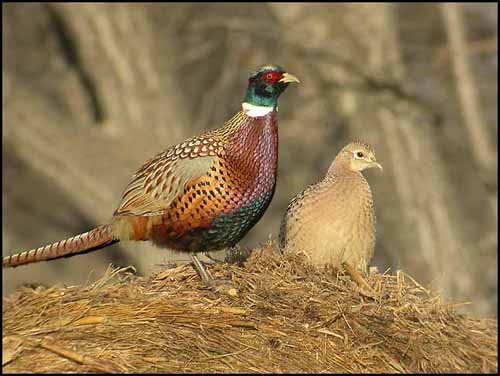Pheasants
General Information
Pheasants of different species tend to be the size of about a large chicken. In some ways they somewhat give an impression of what a wild chicken would be.
Types of Pheasants:
1) Megapodes
2) Chachalacas
3) Curassows
4) Guans
5) Guineafowl
6) New World Quail
Many of the species of Pheasants tend to be commercially raised since they are popular for hunting, and can also be consumed as part of human diet as poultry.
Unfortunately, not all the species of these birds are thriving. A common problem that plagues many of the species of birds throughout the world is that human land development is often destroying their natural habitats, and taking away from the areas where they are able to thrive.
In North America, the Ring-Necked Pheasant is the official bird of South Dakota.
Recognizable Characteristics
Pheasants tend to have a long tail, often held cocked up at an angle. These are usually chicken or small turkey sized, plump birds, often with colorful plumage (males tend to be larger and more colorful).
Migration Pattern
Most Pheasant species do not migrate.
Beak or Bill
Wings
Pheasants tend to have short wings.
Flight
Feet
The males of many species have a spur behind their legs, about half way up their legs.
Colors
These birds tend to have brown to grey plumage that often helps them blend into their environment when on the ground, especially during the Fall when grass and various plants turn brown or yellow.
Reproduction
During the mating process, the males tend to go through very elaborate courting techniques and attempts. If two males are trying to court the same female, they often fight viciously; sometimes until death.
Unfortunately for the females, once the males get what they want, their efforts become much less noticeable. The males usually do not participate in the rearing of the young chicks when they are born.
The nesting season for many Pheasant species is usually May through June.
Difference in Males and Females
Males tend to have a reddish face. Their tails are usually long and pointed. On their legs they usually have a spur halfway up leg.
Females usually have a long, pointed tail brown with black barring.
Generally, the Pheasant family is characterized by strong sexual dimorphism. The males of most species have highly colored plumage, long tails, and wattles which are the sort of strange-looking fleshy, hanging growth extending from the neck or throat.
Other Information
In North America, these birds are one of the most common targets for hunters. These birds are so common in North America that it may seem that they were always here. But that is not true. They were actually brought over from Asia at the end of the 19th century and have adapted to the North American climate and habitats quite well.
Songs and Calls
These birds do not really have a sweet song. They commonly make harsh croaking notes when they feel danger. Males make loud crowing khaaaa-cack.
Diet
Most commonly, these birds tend to eat berries, insects, and various grains and seeds. On more rare occasions they can hunt for animals like mice, snakes, and frogs.
Habitat
These birds tend to do well in open upland and open spaces, including farm fields, brush, woodland edges, hedgerows. They hide well in tall grass and shrubs, which give them natural defense. In their habitats, these birds are often hunted by bigger animals like foxes.
Pheasants Photo
